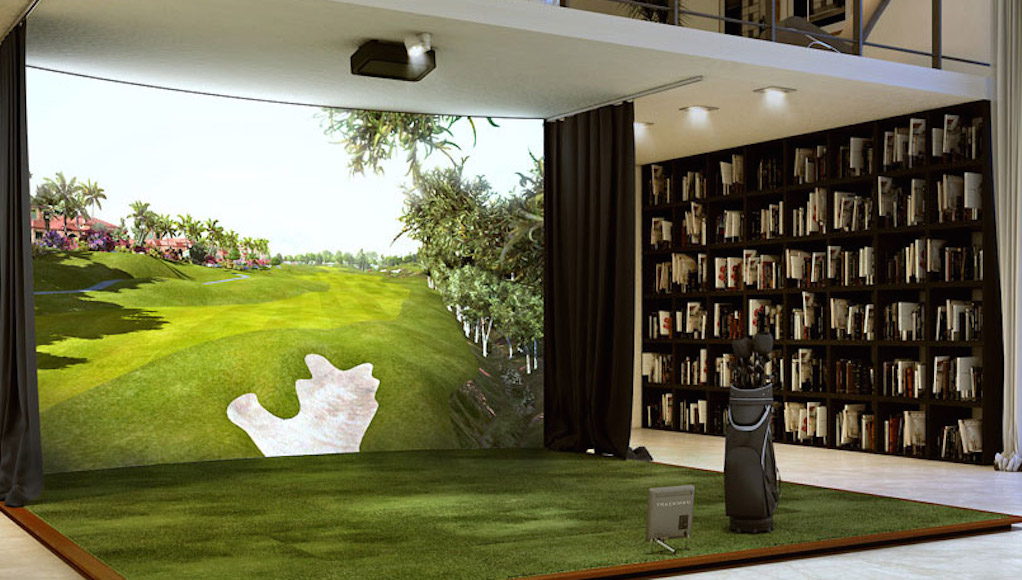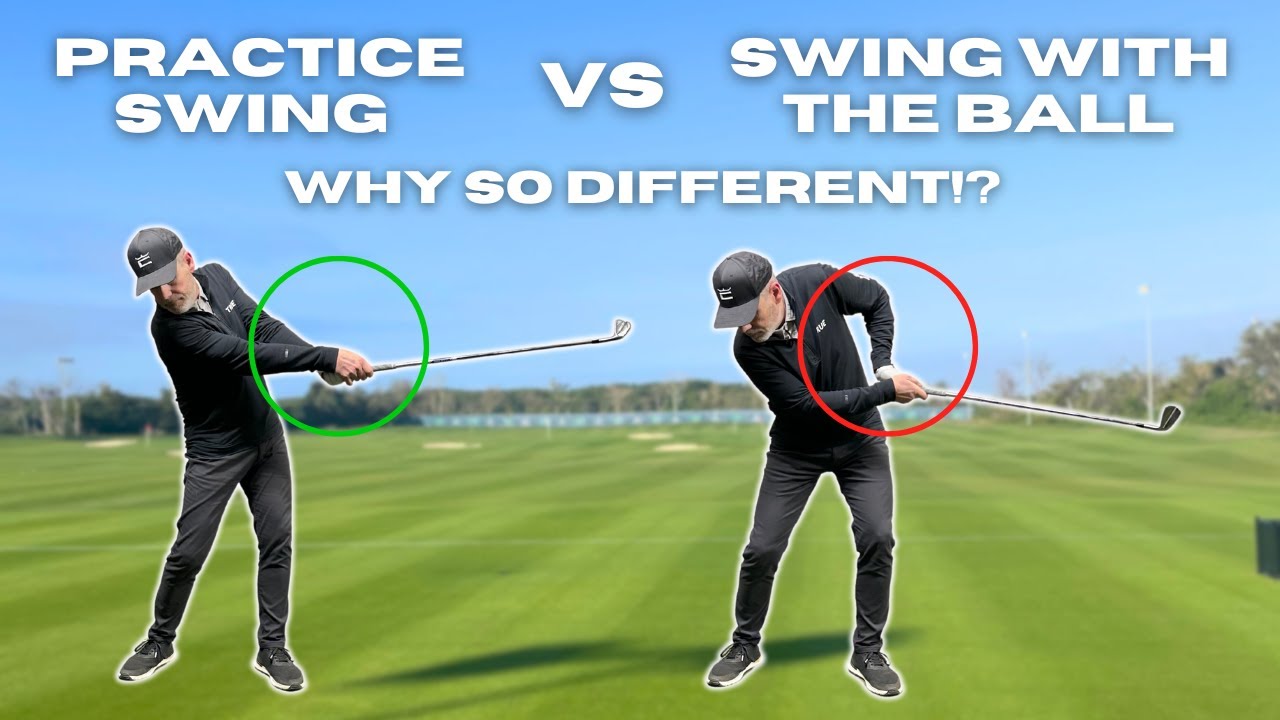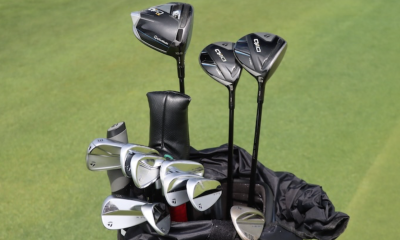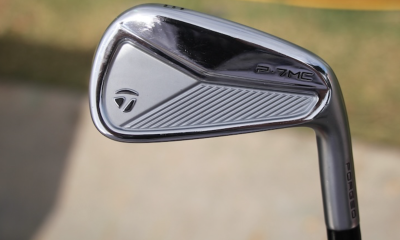Instruction
The best 8 ways to practice indoors with Trackman

In most places in the world it’s getting colder, so most golfers are headed indoors to practice. But don’t fret, there are still ways to get better and practice effectively! As we all know, practice without feedback can be difficult even for the most experienced players. However, I am here to show you a way you can kill two birds with one stone.
By now, most golfers know a teacher or fitter in their area who has a Trackman for teaching and/or fitting purposes. I would highly suggest you contact them to see if they will “rent” you an hour or two per week so you can practice with the unit. In this article, I want to show you how to practice with Trackman so you can work on things just like you would on the range in the middle of your golf season.
Trackman has more than 26 data parameters, but I want you to focus on a few simple ones during your practice sessions:
- Low Point: The club’s lowest point in the swing arc.
- Club Path: The direction of your swing (AoA + swing direction).
- Face Angle: The direction of the face at impact.
- Club Speed: The speed of the club at impact.
- Smash Factor: The correlation of club speed to the resulting ball speed.
- Dynamic Loft: The loft you deliver at impact.
- Carry: How far the ball carries in the air.
- Height: The apex of your ball’s flight.
Let’s take a closer look at each of the parameters.
Low Point
Your low point is mainly influenced by the pivot of your body, so if your pivot is faulty then your low point will be inconsistent, causing you to hit fat and thin shots. This is never more apparent than when you’re hitting short pitch shots. Therefore, my favorite way to work on my short game indoors is to hit 20-50 yard shots while auditing my low point. At this stage, I’m not looking for any specific number — I just want to make sure I have a very consistent range of where my club “bottoms out” after the golf ball. I never want to see my low point changing significantly from swing to swing; if so, I have some work to do.
Club Path
The path of the club is created by two factors: Angle of Attack (AoA) and swing direction. For our purposes, it is only necessary to monitor the path of your club through impact. I want you to hit 7-irons and look for two things:
- Is the path of your club moving in the direction you “feel” it is moving?
- If so, to what degree is it moving in that direction?
I first want you to make sure your path is going in the direction you want it to, because “feel is (often) not real.” If your path is moving in the wrong direction, that’s the first thing we need to fix.
Now let’s assume we ARE swinging in the direction desired. What is the range? It is impossible to swing “X” degrees in-to-out or vice versa every single time, so let’s instead find a 3-degree numerical range we can consistently swing the club. Based on your desired curvature amount, this range can be 1-3, 4-7, 7-10 etc., but 3 degrees would be my suggestion for the masses.
Remember that a path that moves in-to-out on Trackman will be a positive (+) number, while a path that moves out-to-in will be a negative (-) number.
Face Angle
One of the most misunderstood factors in golf is that the face angle at impact (mostly) controls the ball’s initial starting direction. Thus, the ability to get the club face in the correct position at impact is crucial for you to start the ball where you would like it to start.
What I like to do is put a range bucket directly between the ball and the target, and hit a few shots to the right and left of the bucket noting the face angle on Trackman. Then I do the same thing while moving the bucket a little right and a little left of my target. With this drill, I am educating my hands to produce specific starting directions without actively thinking about it. And this is the key to being able to start the ball where you want each time under pressure.
Club head speed
The first way to develop swing speed is simple; learn how to swing the club faster without compromising impact quality. But what is the second way to develop club head speed?
You need to “find” the speed that gives you maximum distance, control, and impact quality. Sometimes this is faster than what you’re used to, other times it can be just the opposite. Everyone has their own speed; think Nick Price versus Payne Stewart. They had different swing speeds, but they were both great players and ball strikers in their own right.
Smash Factor
The quality of your impact is shown with smash factor on Trackman, as it pertains to input versus output. In a perfect world, you would like to transfer maximum energy from the speed of the club head into the ball, which becomes “ball speed.” The better the quality of impact, the more ball speed you will gain with all things being equal. Once again, it’s not about a specific number, but gaining a consistent range of smash factors based on your level. Yes, you can obtain a higher smash factor and hit awful shots, so take smash with a grain of salt. You are striving to hit solid, quality shots with a higher smash factor than you are used to having — that’s the key for this data parameter.
Dynamic Loft
Everyone knows that you can deliver too much loft at impact, but few recognize that you can deliver too little loft at impact as well. Your loft at delivery is one of the biggest keys to controlling your launch angle. With too little loft, you won’t carry the ball as far or be able to hold greens. With too much loft, shots won’t carry far enough and won’t react properly when they land. As you watch your shots fly on the simulator, you can see where they land and how much they chase out per the club used. We want the ball to carry as far as possible and land softly with irons, but with the driver we’d like to carry the ball a fair distance and have it run out when landing. So use your dynamic loft number to control carry and landing angle and you’ll learn to hit more effective shots.
Carry
Try to carry your shots as far as possible with your irons so they will land softly, but remember your driver carry should be optimized for course conditions. If you play soft and wet courses, I would suggest you try carry the ball as far as possible. If the conditions are firmer, you can work on a lower trajectory so the ball lands a touch flatter and runs out more. Experiment with your carry on Trackman and you will see what I mean as it pertains to total distance.
Height
The average height of a golf shot on the LPGA Tour is 75 feet in the air, while on the PGA Tour it’s 95 feet. People have NO idea just how high this is! Most players hit the ball too flat and this compromises distance in the end. Take your time to play around with your height on Trackman and you will see that you probably need to hit it higher than you think in order to get greater distance with softer landings.
Secondly, hit super low and super high golf shots to see how distance changes when you are playing in windy or windless conditions so you can access tight pins. If you cannot alter your trajectory, the game becomes very difficult.
I hope by now you have seen that Trackman can be a very effective learning tool — it can be a full-service practice tool for you all winter if you use it properly. Good luck, practice hard and stay warm!
- LIKE72
- LEGIT15
- WOW2
- LOL2
- IDHT2
- FLOP4
- OB1
- SHANK24
Instruction
Clement: Stop ripping off your swing with this drill!

Not the dreaded headcover under the armpit drill! As if your body is defective and can’t function by itself! Have you seen how incredible the human machine is with all the incredible feats of agility all kinds of athletes are accomplishing? You think your body is so defective (the good Lord is laughing his head off at you) that it needs a headcover tucked under the armpit so you can swing like T-Rex?
- LIKE0
- LEGIT1
- WOW2
- LOL0
- IDHT0
- FLOP0
- OB0
- SHANK2
Instruction
How a towel can fix your golf swing

This is a classic drill that has been used for decades. However, the world of marketed training aids has grown so much during that time that this simple practice has been virtually forgotten. Because why teach people how to play golf using everyday items when you can create and sell a product that reinforces the same thing? Nevertheless, I am here to give you helpful advice without running to the nearest Edwin Watts or adding something to your Amazon cart.
For the “scoring clubs,” having a solid connection between the arms and body during the swing, especially through impact, is paramount to creating long-lasting consistency. And keeping that connection throughout the swing helps rotate the shoulders more to generate more power to help you hit it farther. So, how does this drill work, and what will your game benefit from it? Well, let’s get into it.
Setup
You can use this for basic chip shots up to complete swings. I use this with every club in my bag, up to a 9 or 8-iron. It’s natural to create incrementally more separation between the arms and body as you progress up the set. So doing this with a high iron or a wood is not recommended.
While you set up to hit a ball, simply tuck the towel underneath both armpits. The length of the towel will determine how tight it will be across your chest but don’t make it so loose that it gets in the way of your vision. After both sides are tucked, make some focused swings, keeping both arms firmly connected to the body during the backswing and follow through. (Note: It’s normal to lose connection on your lead arm during your finishing pose.) When you’re ready, put a ball in the way of those swings and get to work.

Get a Better Shoulder Turn
Many of us struggle to have proper shoulder rotation in our golf swing, especially during long layoffs. Making a swing that is all arms and no shoulders is a surefire way to have less control with wedges and less distance with full swings. Notice how I can get in a similar-looking position in both 60° wedge photos. However, one is weak and uncontrollable, while the other is strong and connected. One allows me to use my larger muscles to create my swing, and one doesn’t. The follow-through is another critical point where having a good connection, as well as solid shoulder rotation, is a must. This drill is great for those who tend to have a “chicken wing” form in their lead arm, which happens when it becomes separated from the body through impact.
In full swings, getting your shoulders to rotate in your golf swing is a great way to reinforce proper weight distribution. If your swing is all arms, it’s much harder to get your weight to naturally shift to the inside part of your trail foot in the backswing. Sure, you could make the mistake of “sliding” to get weight on your back foot, but that doesn’t fix the issue. You must turn into your trial leg to generate power. Additionally, look at the difference in separation between my hands and my head in the 8-iron examples. The green picture has more separation and has my hands lower. This will help me lessen my angle of attack and make it easier to hit the inside part of the golf ball, rather than the over-the-top move that the other picture produces.


Stay Better Connected in the Backswing
When you don’t keep everything in your upper body working as one, getting to a good spot at the top of your swing is very hard to do. It would take impeccable timing along with great hand-eye coordination to hit quality shots with any sort of regularity if the arms are working separately from the body.
Notice in the red pictures of both my 60-degree wedge and 8-iron how high my hands are and the fact you can clearly see my shoulder through the gap in my arms. That has happened because the right arm, just above my elbow, has become totally disconnected from my body. That separation causes me to lift my hands as well as lose some of the extension in my left arm. This has been corrected in the green pictures by using this drill to reinforce that connection. It will also make you focus on keeping the lead arm close to your body as well. Because the moment either one loses that relationship, the towel falls.


Conclusion
I have been diligent this year in finding a few drills that target some of the issues that plague my golf game; either by simply forgetting fundamental things or by coming to terms with the faults that have bitten me my whole career. I have found that having a few drills to fall back on to reinforce certain feelings helps me find my game a little easier, and the “towel drill” is most definitely one of them.
- LIKE11
- LEGIT1
- WOW2
- LOL0
- IDHT0
- FLOP2
- OB0
- SHANK8
Instruction
Clement: Why your practice swing never sucks

You hear that one all the time; I wish I could put my practice swing on the ball! We explain the huge importance of what to focus on to allow the ball to be perfectly in the way of your practice swing. Enjoy!
- LIKE0
- LEGIT0
- WOW0
- LOL0
- IDHT0
- FLOP0
- OB0
- SHANK2
-

 19th Hole2 days ago
19th Hole2 days agoJohn Daly stuns fans into silence with brutal opening tee shot on PGA Tour Champions
-

 19th Hole3 weeks ago
19th Hole3 weeks agoPaulina Gretzky opens up on receiving death threats following DJ’s move to LIV Golf
-

 19th Hole6 days ago
19th Hole6 days ago2-time major champ announces shock retirement from the sport at age of 33
-

 19th Hole7 days ago
19th Hole7 days agoEdoardo Molinari reveals the latest PGA Tour golfer to turn down ‘good offer’ from LIV Golf
-

 19th Hole1 week ago
19th Hole1 week agoScottie Scheffler had an interesting response when asked how he ‘quiets the noise’ following Players victory
-

 19th Hole1 week ago
19th Hole1 week agoJon Rahm dealt fresh blow to hopes of qualifying for 2025 Ryder Cup
-

 Equipment2 weeks ago
Equipment2 weeks agoBest driver 2024: The best driver for you, as recommend by expert club fitters
-

 19th Hole2 days ago
19th Hole2 days agoCharlie Woods finds it tough going on American Junior Golf Association debut





















Marty
Dec 16, 2015 at 2:50 pm
A few comments from reading replies. One, track man is well over $20,000. Two, The distances it records will seem inflated, as it is showing you roll out based on PGA tour courses. These fairways are extremely fast and hard in comparison to a normal course. Three, foresight CG2 with HMT is definitely better for clubhead position and knowing what the Clubhead is doing. But I do find their numbers are a little off on the low side. This is in comparison to Doppler radar systems (trackman, flightscope) which record actual ball speed in flight, not cameras calculating speed based on a few images in a foot window.
Poppa
Dec 14, 2015 at 4:22 pm
I fit people all day and I believe the author is mistaken. 99% of golfers need to focus on learning how to swing rather than focus on numbers. Also, nearly everyone I see hits the ball way too high. They scoop and flip with a 6 iron peak height well above 30 yards. Stop buying clubs and buy lessons!
Marty
Dec 16, 2015 at 2:55 pm
Pappa, while I wholeheartedly agree with you, on the point of lessons are more valuable than new clubs. The reality is most people barely have time to play a round of golf, let alone spend hours of time and hundreds of dollars on lessons. I do believe people can fix their own swing in a relatively short amount of time, to make it functional. Unfortunately most coaches want to change their swing completely to a style that the coach understands or prefers. Most people don’t have that much time, as a swing change can take a very long time. And you will get worse before you get better with this methodology. This can be disheartening to most players. It just seems easier to walk into a store pick up a brand-new club and walk out. Even if it is the wrong way.
golfraven
Dec 14, 2015 at 9:21 am
If you are a serious golfer don’t bother putting a deposit on a house, buy a Tracman and rent a house. You wife will love you for sure. Or tell your kids to start working and earn money if they want to go to university. Come on man, life is nit worth living without a Tracman.
Jmoney
Dec 13, 2015 at 11:31 am
I’ve got Foresight with the HMT…love it and used it up against a Trackman and it was more accurate to me. Didn’t give me inflated numbers like trackman can do at times. Cheaper and a better setup for limited space for in home sim. That being said, I’m not hating on Trackman. It’s great but I like Foresight’s science and technology better.
jakeanderson
Dec 13, 2015 at 10:39 am
where can i get a simulator like that and what does it cost?
Christian
Dec 14, 2015 at 1:18 am
Jake,
Check out http://trackmangolf.com/products/simulator for more information 🙂
Christian
TrackMan
Chuck
Dec 12, 2015 at 5:21 pm
That room in the picture looks too good to be true. It’s gorgeous. Where is it? What do you hit into? Is there a net that has been taken down?
The column is all excellent advice. Now I just need a trackman. What does a Trackman go for these days?
DJ
Dec 12, 2015 at 7:32 pm
That’s just the generic picture that trackman uses on their site. Dream room!
Um.....Hemispheres
Dec 12, 2015 at 3:44 pm
“In most places in the world it’s getting colder…..”
?
other paul
Dec 13, 2015 at 2:38 am
I thought about half was getting warmer and about half was getting colder… People always speak from their own perspective, what he said was “most places in the world are getting colder”. What he was trying to say was that where a lot of the world’s golfers are is getting colder. And he was thinking that its getting cold outside for himself, so it must be that way for everyone. It’s just the way our brains work. Its why our wives dont understand our love for golf 🙁
Tom
Dec 12, 2015 at 2:54 pm
“If you cannot alter your trajectory, the game becomes very difficult.”
This is so true! I do not really recall hearing it until recently. When I was just a high ball hitter in my youth I had a lot of problems. Had it even dawned on me the importance of being able to alter trajectory I am sure I would have minimized those problems and been a better player.